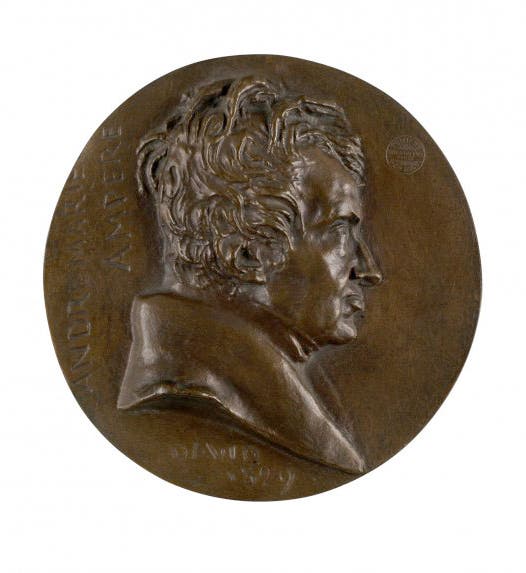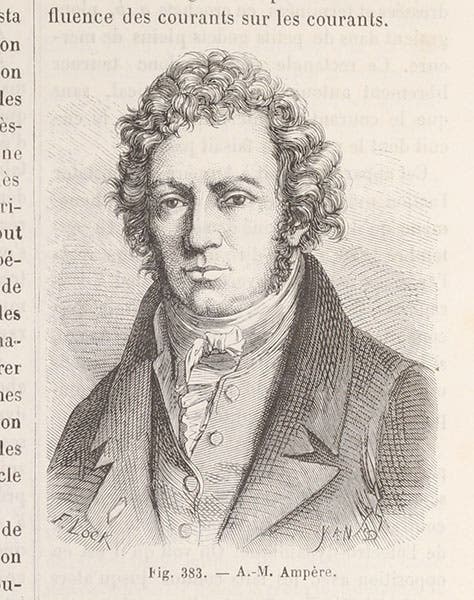Scientist of the Day - André-Marie Ampère
André-Marie Ampère, a French mathematician and chemist, was born Jan. 20, 1775. Ampère was one of the pioneeres in the study of electrodynamics, the science that deals with the effects of electricity in motion, and of electromagnetism. In the spring of 1820, the Danish scientist Hans Christian Ørsted had discovered that a compass needle is deflected by a current moving through a nearby wire; in short, that electricity produces a magnetic effect. This ran counter to a well-established view that electricity and magnetism are completely separate phenomena. François Arago witnessed a demonstration of the Ørsted experiment in Switzerland and revealed Ørsted’s discovery to a meeting of the French Academy of Sciences in Paris on Sep. 11, 1820. Ampère was at that meeting, and he immediately went to his lab, grabbed his Voltaic cell, and redid the Ørsted experiment again and again, with variations. Ampère noticed something that Ørsted had not – that the deflection of the compass varies, depending on the orientation of the Earth's magnetic field. He found a way to negate terrestrial magnetism and discovered that in those circumstances, the compass needle always points at right angles to the wire carrying current, no matter where you hold it. He concluded almost immediately that an electric current creates magnetism (the term magnetic field was not yet in use), and proceeded to do a whole series of experiments, coiling wires into helices and spirals, to see what kinds of magnetic effects were produced. Almost by chance, doing one of his experiments with coils, he discovered that two wires close to each other and carrying current in the same direction are attracted to each other, just like two magnets. He sought to see if there were any effects of a permanent magnet that he could not duplicate with his "electromagnetic" wires. He found there were not, and he came to the greater conclusion that all magnetism is a result of electricity in motion, even in permanent magnets, where there must be some tiny electrical currents at work.
Ampère revealed his discoveries at the next two meetings of the Paris Academy, on Sep. 18. and Sep. 25, 1820, and accounts of those presentations were immediately published in the Annales de chimie et de la physique. We have a complete run of that journal in our serials collection, and we show here, from volume 15 (1820), the beginning of Ampère‘s presentation of Oct. 2, 1820, which begins with the discovery that two wires carrying current attract or repel each other (second image), and a plate published with his paper, illustrating two of his experimental set-ups (third image). Ampère published a great deal on electromagnetism in the next 6 years, and in addition to the many journal articles, we have in our collections three of his book publications, including his Théorie des phénomenes électro-dynamiques, uniquement deduite de l'experience (1826), which morphed into his more famous Mémoire sur la théorie mathématique des phénomenénes électrodynamiques (1827), which we do not have. It is hard to tell what the differences are, without both in hand.
Ampère discovered nearly everything that could be discovered about electromagnetism at the time, except electromagnetic induction, which would have to await Michael Faraday and Joseph Henry in 1831 and 1832. Ampère, not surprisingly, was one of the 72 French scientists chosen to be commemorated on the Eiffel Tower in 1889, and his name was applied to the unit of electric current, the ampere (often shortened to amp), which is one of the seven basic units in the International System of Units (SI) adopted in 1960.
Louis Figuier in his Les merveilles de la science (1867) provided the public with wood engravings of Ampère’s experimental apparatus (above) and his portrait (below). A classier portrait can be seen on a medal by the great David d’Angers in the Walters Art Gallery (first image).
Dr. William B. Ashworth, Jr., Consultant for the History of Science, Linda Hall Library and Associate Professor emeritus, Department of History, University of Missouri-Kansas City. Comments or corrections are welcome; please direct to ashworthw@umkc.edu.






![Columbine, hand-colored woodcut, [Gart der Gesundheit], printed by Peter Schoeffer, Mainz, chap. 162, 1485 (Linda Hall Library)](https://assets-us-01.kc-usercontent.com:443/9dd25524-761a-000d-d79f-86a5086d4774/3829b99e-a030-4a36-8bdd-27295454c30c/gart1.jpg?w=210&h=210&auto=format&fit=crop)



